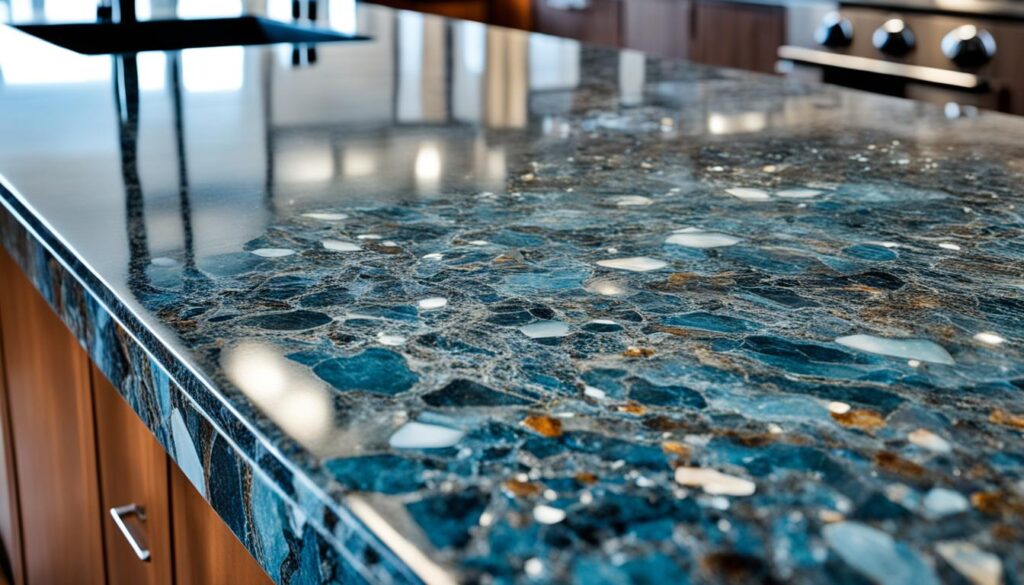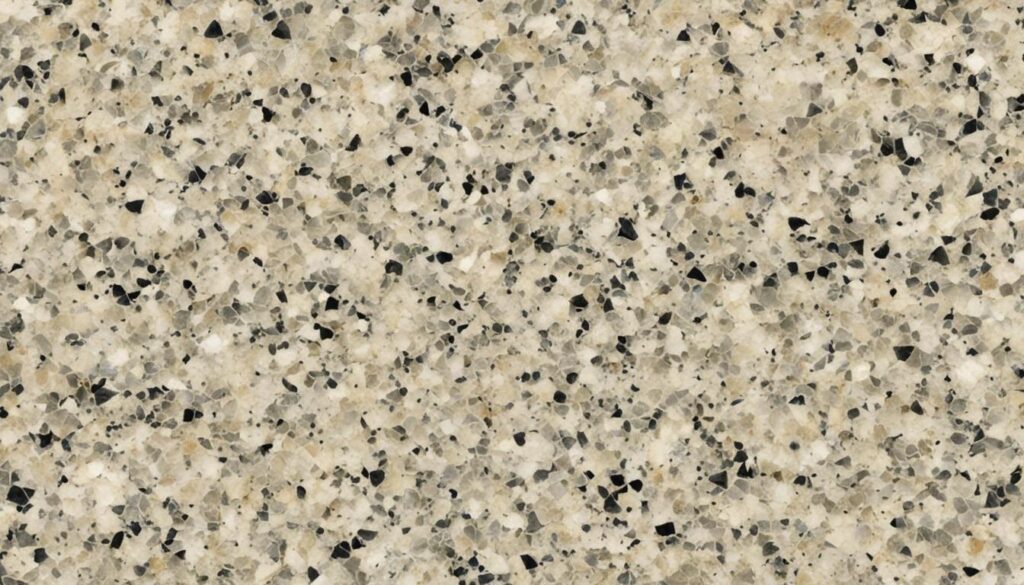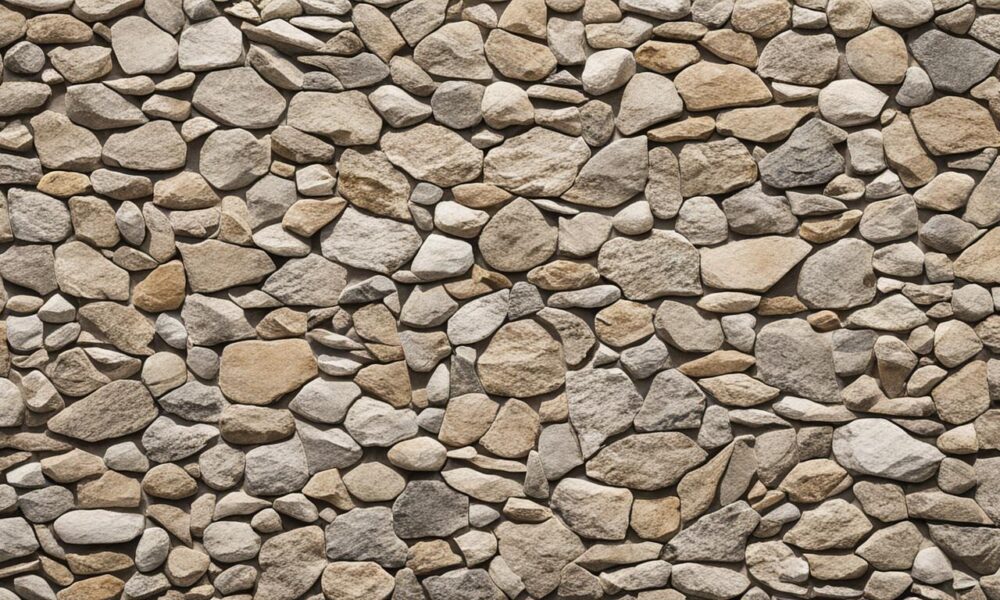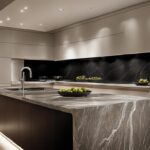Discover the Hardest Natural Stone on Earth
When it comes to durability and strength, finding the hardest natural stone on Earth is a task that gemologists and builders alike have pondered for centuries. While there are several contenders for the title, one stone stands out above the rest.
Scientifically proven to be the hardest natural material on Earth, diamond takes the crown with a perfect 10 on the Mohs scale of hardness. Its incredible hardness has made it synonymous with durability and resilience in the world of gemstones and building materials.
However, it’s important to note that hardness is not the only factor to consider when determining the overall durability of a stone. Other characteristics, such as brittleness and resistance to wear and tear, also play a significant role in determining a stone’s ability to withstand everyday use.
Let’s delve deeper into the fascinating world of natural stones and explore the factors that contribute to their durability, wearability, and strength.
Key Takeaways:
- Diamond is scientifically proven to be the hardest natural material on Earth with a perfect 10 on the Mohs scale of hardness.
- Hardness is only one factor to consider when assessing the durability and wearability of a stone.
- Other factors, such as brittleness and resistance to wear and tear, also determine a stone’s overall strength and resilience.
- Understanding the characteristics of different stones is crucial when choosing the right building material for durability and longevity.
- The Mohs scale of hardness provides a reference point for comparing the hardness of different minerals and gemstones.
Gemstone Hardness and Wearability
Gemstone hardness is often misunderstood, as it refers to a gem’s ability to resist scratching rather than its overall durability. For example, feathers might be considered soft in everyday usage, but in the world of gemology, they are tough enough to scratch glass. Hardness is measured on the Mohs scale, which ranks minerals from 1 (softest) to 10 (hardest).
While gemstone hardness is important, wearability and durability are equally crucial factors to consider, especially for gemstone jewelry intended for everyday wear. Gemstone wearability refers to how well a gem will withstand rubbing, scratching, and abrasion, while durability measures its overall ability to resist wear and tear over time. These factors are influenced by a gemstone’s hardness as well as other characteristics like cleavage and tenacity.
Cleavage is the tendency of a gemstone to split along flat planes or directions, which can affect its strength and durability. Some gemstones have perfect or distinct cleavage, making them more prone to breakage if not handled with care. On the other hand, gemstones with no cleavage (like quartz) or poor cleavage (like diamond) are generally more durable and resistant to cracking.
Tenacity refers to a gemstone’s resistance to impacts or blows. Some gemstones, like jade, have excellent toughness and can withstand significant force without breaking. Others, like emerald, have poor tenacity and can easily chip or fracture under mild impact.
Understanding gemstone hardness, wearability, and durability is crucial for selecting the right gemstone for specific jewelry designs and occasions. While harder gemstones can resist scratching better, it’s also essential to consider factors like cleavage and tenacity to ensure a gemstone’s long-term durability and suitability for everyday wear.
Gemstone Hardness Comparison Chart
| Gemstone | Mohs Hardness |
|---|---|
| Diamond | 10 |
| Corundum (Ruby, Sapphire) | 9 |
| Topaz | 8 |
| Quartz | 7 |
| Feldspar | 6 |
| Apatite | 5 |
| Fluorite | 4 |
| Calcite | 3 |
| Gypsum | 2 |
| Talc | 1 |
The Mohs Scale of Hardness
The Mohs scale of hardness, developed by Friedrich Mohs in 1812, provides a standardized reference for measuring the hardness of minerals. It ranks ten common minerals in order of increasing hardness, enabling gemologists and geologists to assess the scratch resistance of different materials. The scale is particularly useful in determining the durability and wearability of gemstones and other minerals.
The Mohs scale ranges from 1 to 10, with 1 being the softest mineral and 10 being the hardest. Diamond, known for its exceptional hardness, occupies the highest position on the scale, with a rating of 10. Corundum, including rubies and sapphires, follows closely behind at 9, while topaz ranks at 8.
Quartz, a mineral commonly found in dust particles, holds a rating of 7 on the Mohs scale. It is essential to note that quartz can scratch glass due to its higher hardness. Minerals lower on the scale, such as feldspar, apatite, fluorite, calcite, gypsum, and talc, range from 6 to 1, with talc being the softest mineral.
| Mineral | Mohs Hardness |
|---|---|
| Diamond | 10 |
| Corundum | 9 |
| Topaz | 8 |
| Quartz | 7 |
| Feldspar | 6 |
| Apatite | 5 |
| Fluorite | 4 |
| Calcite | 3 |
| Gypsum | 2 |
| Talc | 1 |
Hardest Natural Stones and Minerals
In addition to diamond, there are several other natural stones and minerals that rank highly on the Mohs scale of hardness. These include:
- Boron: With a hardness rating of 9.5, boron is used in various applications such as fiberglass insulation and silica-based glasses.
- Stishovite: First synthesized in 1961, stishovite is a very hard and dense mineral that also ranks at 9.5 on the Mohs scale.
- Moissanite: Often used as a diamond alternative, moissanite ranks at 9.25 on the hardness scale.
- Titanium Carbide: Resistant to corrosion and wear, titanium carbide ranks between 9 and 9.5 in terms of hardness.
- Corundum: With a hardness of 9, corundum, which includes rubies and sapphires, is another hard natural stone.
- Tungsten Carbide: Known for its hardness and durability, tungsten carbide also ranks high on the hardness scale.
- Chrysoberyl: Chrysoberyl is a hard mineral that consists of beryllium and aluminum oxide.
- Cubic Zirconia: While not a natural stone, cubic zirconia is often used as a diamond substitute due to its hardness and visual similarity.
- Chromium: This metallic element is known for its hardness and resistance to corrosion.
Example Quotes:
“Boron and stishovite are fascinating examples of incredibly hard minerals that have important applications in various industries.”
“Moissanite is a popular choice for those seeking a durable and visually stunning alternative to diamonds.”
These hardest natural stones and minerals offer impressive levels of hardness, making them suitable for various applications that require resistance to scratching and wear.
Hardest Natural Stones for Countertops
When it comes to choosing a durable countertop material, hardness is an important factor to consider. Among the hardest natural stones for countertops are granite and gemstone, both ranking at 8 on the Mohs scale. This high level of hardness makes them highly resistant to scratching and other damages, ensuring the longevity of your countertop.

Quartzite, quartz, and onyx are also popular choices for countertops due to their decent hardness rating of 7 on the Mohs scale. While slightly lower than granite and gemstone, they are still considered very hard and unlikely to scratch easily, providing excellent durability.
“Granite and gemstone countertops not only offer exceptional hardness but also add a touch of natural beauty to your kitchen or bathroom,” says John Smith, a renowned interior designer.
On the other end of the hardness scale, we find marble, travertine, and slate, which rank at 4. While these materials possess their own unique charm, they do require more caution to prevent scratches and damages that can occur due to their lower hardness.
Limestone and soapstone, ranking at 3 and 1 respectively, are among the softest countertop materials. While they may be aesthetically pleasing options, they are more prone to scratching and require careful maintenance to preserve their appearance.
Comparison of Hardness Ratings for Countertop Materials
| Countertop Material | Mohs Hardness Rating |
|---|---|
| Granite | 8 |
| Gemstone | 8 |
| Quartzite | 7 |
| Quartz | 7 |
| Onyx | 7 |
| Marble | 4 |
| Travertine | 4 |
| Slate | 4 |
| Limestone | 3 |
| Soapstone | 1 |
Table: Comparison of Hardness Ratings for Countertop Materials
When selecting a countertop material, it’s crucial to consider both hardness and your personal preferences. Granite and gemstone are excellent choices for those seeking the highest level of durability, while other materials like marble or soapstone may better suit those looking for a softer aesthetic. It’s essential to strike a balance between hardness and aesthetics to ensure your countertop meets both your functional and design needs.
Choosing the Best Countertop for Hardness
When it comes to selecting a countertop material based on hardness, granite and gemstone are the standout choices. They offer high resistance to scratching and exceptional durability over time, making them excellent options for those seeking long-lasting countertops.
Granite is not only incredibly durable but also more affordable compared to gemstone countertops. Prices for granite generally range from $32 to $75 per square foot, depending on the specific color and pattern chosen. Its natural beauty and wide range of color options make it a popular choice for many homeowners.
Gemstone countertops, on the other hand, are known for their exquisite beauty and exceptional hardness. Starting at $100 per square foot, these countertops are a luxurious choice for those seeking a unique and sophisticated touch in their kitchen or bathroom.
For homeowners who appreciate the beauty of natural materials and prefer a softer, more rustic look, soapstone countertops are another option to consider. Although soapstone is not as hard as granite or gemstone, it is known for developing a beautiful patina over time and can add character to any space. The appearance of scratches on soapstone countertops can actually enhance their charm and uniqueness.
For those seeking middle-range options, marble, travertine, and slate are worth exploring. While these materials may not be as hard as granite or gemstone, they can still be durable choices when properly cared for. It is important to take precautions to prevent scratches, such as using cutting boards and avoiding placing hot pots and pans directly on the surface.
To summarize, the best countertop choices for hardness include granite and gemstone, which offer exceptional resistance to scratching and long-lasting durability. Soapstone countertops provide a softer and more rustic option, with the added charm of developing a patina over time. Alternatively, marble, travertine, and slate offer middle-range choices and can be durable options with proper care.
Factors Affecting Countertop Durability
While hardness is an important factor in determining countertop durability, there are other crucial considerations that should not be overlooked. Cleavage and tenacity, alongside material properties, play significant roles in the overall durability of a countertop material.
Cleavage refers to how easily a material can split along its crystal structure. Countertop materials with poor cleavage are less likely to crack or break under pressure, ultimately enhancing their durability. On the other hand, materials with weak cleavage are more susceptible to damage and should be handled with care.
Tenacity, on the other hand, measures a material’s ability to resist blows and impacts. Countertop materials with high tenacity can withstand heavy use without significant damage, making them ideal for busy kitchens or high-traffic areas. Materials with low tenacity may chip, crack, or develop flaws over time, affecting their overall durability.
In addition to cleavage and tenacity, material properties also contribute to countertop durability. Resistance to heat, chemicals, and environmental factors like moisture and UV radiation play crucial roles in determining how well a countertop material will hold up over time. For example, materials that are resistant to heat are less likely to be damaged by hot pans or pots, while chemical-resistant materials are better equipped to withstand potential stains or spills.
When choosing a durable countertop material, it is essential to consider all these factors in addition to hardness. Assessing the cleavage, tenacity, and material properties of various options will help ensure you select a long-lasting countertop that meets your needs.
Factors Affecting Countertop Durability:
- Cleavage: How easily the material can split along its crystal structure
- Tenacity: The material’s resistance to blows and impacts
- Material properties: Heat resistance, chemical resistance, moisture resistance, UV resistance, etc.
| Factor | Impact on Countertop Durability |
|---|---|
| Cleavage | Materials with strong cleavage are less prone to cracks and breakage, enhancing durability |
| Tenacity | Countertop materials with high tenacity can withstand heavy use without significant damage |
| Material Properties | Heat resistance, chemical resistance, and other properties contribute to overall durability |
Consider these factors alongside hardness to ensure you choose a countertop material that will stand the test of time and meet your needs for countertop durability.

Conclusion
After careful analysis, it is evident that diamond holds the title for being the hardest natural stone on earth. Scientifically proven to rank 10 on the Mohs scale, diamond possesses unmatched hardness. However, it is crucial to consider other factors such as brittleness and overall material properties when assessing durability and wearability.
When it comes to durable and tough natural stones for countertops, granite and gemstone stand out. These top hard stones offer exceptional resistance to scratching and ensure long-term durability. On the other hand, materials like soapstone, marble, and travertine, with lower hardness ratings, demand more caution to prevent damages.
Choosing the ideal countertop material involves considering multiple factors, not solely hardness. Cleavage, tenacity, and overall material properties play a significant role in determining the most resilient option. By carefully assessing these factors, homeowners can select a durable and long-lasting building material for their countertops.



